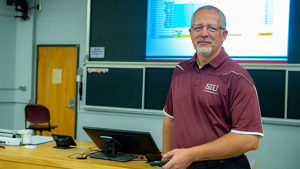CARBONDALE (SIU NEWS) — The deadly collapse of the 1.6-mile, four-lane Francis Scott Key Bridge in Baltimore after it was hit by a container ship early Tuesday morning “will likely have long-term consequences for the local, regional, and at least in the short-term, national economy,” said Gregory D. DeYong, a Southern Illinois University Carbondale associate professor of operations management.

“Supply chain activities don’t take place in a vacuum,” he said. “Trucks, trains and even ocean-going vessels do interact with the public. We often don’t even notice this until something tragic occurs.”
Experts are unsure at this point how long the port will be closed, how extensive the damage is, what the difficulty and timeline of the clean-up operations will be or how long it will take before things are back to normal.
“Although replacing the Francis Scott Key bridge may take years, I would expect the port to reopen and resume normal operations much sooner, likely within a few months,” DeYong said. “In the meantime, we may all feel the impact of that ship-bridge collision in one way or another for a while.”
DeYong said the impact of the accident will be felt in many ways:
- There will be an immediate impact on vessels that are essentially trapped inside the Baltimore port as they will have to wait until an exit path is restored. “The Port of Baltimore isn’t one of the nation’s largest ports, but it is consistently ranked in the top 10 for both tonnage and value,” he said.
- Vessels which were scheduled to arrive at the port within the next few days will have to be delayed or rerouted. He said current information shows 34 ships were scheduled to arrive at the port in the next 30 days, and companies are likely working to reroute them all to other ports in the region, if possible.
- Rerouting poses some serious challenges:
- DeYong said the Port of Baltimore “offers some fairly unique capabilities that could take even longer to restore” including a 50-foot-deep channel that allows access to even the largest cargo vessels and numerous particularly large cranes that allow loading and unloading of these vessels, which cannot access all of the East Coast ports. “Restoring these capabilities could take the longest and cause the most disruption,” he said.
- The port also has some unique specializations when it comes to handling some specific products for shipping. “It is particularly important in the automotive, machinery and equipment market, as it has consistently led the nation in both importing and exporting vehicles,” DeYong said. “The port also ranks No. 1 for imported sugar, and it is likewise very important in terms of other commodities such as coal, gypsum and liquefied natural gas, which require specialized handling equipment for efficient loading and unloading. These specific capabilities will be the hardest to replace while the port is closed.”
- In the past 5-10 years, there has been a continuous movement to reroute cargo from West Coast to East Coast ports, DeYong said, resulting in the Port of New York/New Jersey becoming the nation’s busiest port just last year and causing other East Coast ports to see rapid growth. “With this added volume already happening at other ports along the Eastern seaboard, it makes rerouting of Baltimore traffic more difficult than it would have been in years past,” DeYong said.
DeYong has personal experience as well as professional knowledge in supply chain management. Before becoming an SIU faculty member, he worked as an import/export manager where he was responsible for about $100 million in products annually. DeYong is currently working to establish a Center for Supply Chain Management and Logistics within SIU’s College of Business and Analytics.
